Exploring the Influence Mechanism of Attractiveness on Wuhan’s Urban Commercial Centers by Modifying the Classic Retail Model
Abstract
:1. Introduction
2. Literature Review
2.1. Factors Affecting the Attractiveness of Commercial Centers
2.2. Development of the Retail Model
2.3. Age Influences the Choice of Shopping Destination
3. Material and Methods
3.1. Commercial Centers
3.2. Sample Blocks
3.3. Data Sources
3.4. Research Methods
3.4.1. Expanding the Retail Model
3.4.2. Building a Matrix of Spatial Interaction Flows
3.4.3. Solving the Optimal Model Using MATLAB
3.4.4. Conducting Age Group Controlled Experiments
4. Results and Analysis
4.1. Attractive Characteristics of Wuhan’s Commercial Center
4.1.1. Obvious Attractiveness Gap
4.1.2. Six Commercial Centers Are Less Attractive Than Planned
4.1.3. Single Factor Is Not Capable to Explain Attractivess
4.2. Influencing Factors and Mechanisms of the Attractiveness of Wuhan’s Commercial Centers
4.2.1. Modeling Results
4.2.2. Industry Density
4.2.3. Length of Development
4.2.4. Traffic Resistance
4.2.5. Differences of the Influence between Factors
5. Conclusions
5.1. Summary
5.2. Policy Recommendations
Author Contributions
Funding
Institutional Review Board Statement
Informed Consent Statement
Data Availability Statement
Conflicts of Interest
References
- Ren, X.H. Understanding Urban Spatial Structure of Shanghai Central City Based on Mobile Phone Data. China City Plan. Rev. 2016, 24, 26–28. [Google Scholar]
- Zhang, X.C.; Shan, Z.R.; Xu, S.C.; Hong, S.J. Connotation·Model·Value: The Review, Comparison and Expectation on Urban Governance Research in Western Counties and China. Urban Dev. Stud. 2016, 23, 2. [Google Scholar]
- Berry, B.J.L. Market Centers and Retail Location: Theory and Applications; Prentice Hall: Hoboken, NJ, USA, 1988. [Google Scholar]
- Liu, X.Y. Circulate Economy; Capital University of Economics and Business Press: Beijing, China, 2008. [Google Scholar]
- Feng, X.; Lu, R.Y.; Liu, D.W. The Analysis of Attraction of Retailing Bussiness Circle. Commer. Res. 2004, 24, 117–120. [Google Scholar]
- Dolega, L.; Pavlis, M.; Singletton, A. Estimating Attractiveness, Hierarchy, and Catchment Area Extents for a National Set of Retail Centre Agglomerations. J. Retail. Consum. Serv. 2016, 28, 78–90. [Google Scholar] [CrossRef] [Green Version]
- Shan, Z.R.; Lin, H.; Yuan, M.; Huang, Y.P. Empirical Study on the Effect of Offline Shopping and Entertainment Travel Restriction in Wuhan During the Epidemic Period. Econ. Geogr. 2020, 40, 96–102. [Google Scholar]
- Zhang, J. Research on Optimization of Commercial Service Facilities Space Layout from the Perspective of Spatialtemporal Behavior; Tongji University Press: Shanghai, China, 2018. [Google Scholar]
- Cheng, Z.C.; Hou, L. Exploring Effctive Mode of Planning Control and Guidance: New Paradigm of Urban Commercial Network Planning. Urban Plan. 2011, 35, 26–29. [Google Scholar]
- Converse, P.D. New Laws of Retail Gravitation. J. Mark. 1950, 14, 379–384. [Google Scholar] [CrossRef]
- Xue, L.; Yang, K.Z. Spatial Planning of Commercial Allocation in Haidian District in Beijing Based on Spatial Interactive Model. Geogr. Res. 2005, 24, 265–273. [Google Scholar]
- Birkin, M.; Clarke, R. Refining and Operationalizing Entropy-Maximizing Models for Business Applications. Geogr. Anal. 2010, 42, 422–445. [Google Scholar] [CrossRef]
- Phiri, P.A. Calculation of the Equilibrium Configuration of Shopping Facility Sizes. Environ. Plan. A 1980, 12, 983–1000. [Google Scholar] [CrossRef]
- Sevtsuk, A.; Kalvo, R. Patronage of Urban Commercial Clusters: A Network-based Extension of the Huff Model for Balancing Location and Size. Environ. Plan. B Urban Anal. City Sci. 2017, 45, 508–528. [Google Scholar] [CrossRef] [Green Version]
- Reilly, W.J. Method for the Study of Retail Relationships; University of Texas: Austin, TX, USA, 1929. [Google Scholar]
- Huff, D.L. A Probabilistic Analysis of Shopping Center Trade Centers. Land Econ. 1963, 39, 81–90. [Google Scholar] [CrossRef]
- Harris, B.; Wilson, A.G. Equilibrium Values and Dynamics of Attractiveness Terms in Production-Constrained Spatial-Interaction Models. Environ. Plan. A 1978, 10, 371–388. [Google Scholar] [CrossRef]
- Wilson, A.G. Boltzmann, Lotka and Volterra and Spatial Structural Evolution: An Integrated Methodology for Some Dynamical Systems. J. R. Soc. Interface 2008, 5, 865–871. [Google Scholar] [CrossRef] [PubMed]
- Dearden, J.; Wilson, A.G. A Framework for Exploring Urban Retail Discontinuities. Geogr. Anal. 2011, 43, 172–187. [Google Scholar] [CrossRef]
- Piovani, D.; Molinero, C.; Wilson, A.G. Urban Retail Location: Insights from Percolation Theory and Spatial Interaction Modeling. PLoS ONE 2017, 12, e0185787. [Google Scholar] [CrossRef] [PubMed] [Green Version]
- Wilson, A.G. A Statistical Theory of Spatial Distribution Models. Transp. Res. 1967, 1, 253–269. [Google Scholar] [CrossRef]
- Christaller, W. Central Places in Southern Germany; Prentice Hall: London, UK, 1966. [Google Scholar]
- Schlaich, T.; Horn, A.L.; Fuhrmann, M. A Gravity-Based Food Flow Model to Identify the Source of Foodborne Disease Outbreaks. Int. J. Environ. Res. Public Health 2020, 17, 444. [Google Scholar] [CrossRef] [Green Version]
- Zhou, S.H.; Lin, G.; Yan, X.P. The Relationship Among Consumer’s Travel Behavior, Urban Commercial and Residential Spatial Structure in Gunagzhou, China. Acta Geogr. Sin. 2008, 63, 395–404. [Google Scholar]
- Tan, Y.T. The Research on the Evolution of Spatial Structure for Urban Retail Business; Hunan University of Science and Technology: Xiangtan, China, 2019. [Google Scholar]
- Wakerfield, K.L.; Baker, J. Excitement at the Mall: Determinants and Effects on Shopping Response. J. Retail. 1998, 74, 515–539. [Google Scholar] [CrossRef]
- Bacon, R.W. Combined Trips and the Frequency of Shopping. J. Retail. Consum. Serv. 1995, 2, 175–183. [Google Scholar] [CrossRef]
- Lakshmanan, J.R.; Hansen, W.G. A Retail Market Potential Model. J. Am. Plan. Assoc. 1965, 31, 134–143. [Google Scholar] [CrossRef]
- Wilson, A.G. The Use of the Concept of Entropy in System Modelling. J. Oper. Res. Soc. 1970, 21, 247–265. [Google Scholar] [CrossRef]
- Clarke, M.; Wilson, A.G. The Dynamics of Urban Spatial Structure: The Progress of a Research Programme. Trans. Inst. Br. Geogr. 1985, 10, 427–451. [Google Scholar] [CrossRef]
- Ellam, L.; Girolami, M.; Pavliotis, G.A. Stochastic Modelling of Urban Structure. Proc. R. Soc. A Math. Phys. Eng. Sci. 2018, 474, 2213. [Google Scholar] [CrossRef] [Green Version]
- Zhao, P.J.; Yu, Z.; Jia, Y.T. Shopping Travel Range and Its Determinants in Rural Towns of China. Econ. Geogr. 2019, 39, 72–81. [Google Scholar]
- Shan, Z.R.; Huang, Y.P.; Zhang, X.C. A Research on Spatial Evolution of Metropolitan Area in Developed Countries since 1990. Urban Plan. Forum 2014, 5, 54–64. [Google Scholar]
- Wang, D.; Wang, C.; Xie, D.C.; Zhong, W.J. Comparison of Retail Trade Areas of Retail Centers with Different Hierarchical Levels: A Case Study of East Nanjing Road, Wujiaochang, Anshan Road in Shanghai. Urban Plan. Forum 2015, 3, 50–60. [Google Scholar]
- Zhang, X.C.; Lv, B.; Xv, S.C.; Long, D.; Chen, P. Polycentric Network Governance Mechanism Research on Chang-Zhu-Tan Urban Agglomeration. Urban Dev. Stud. 2015, 22, 28–37. [Google Scholar]
- Lin, M.H.; Zhen, F.; Zhu, S.J. Urban Residents’ Activity Diversity and Its Influential Factors in Nanjing City. Trop. Geogr. 2017, 37, 400–408. [Google Scholar]
- Douard, J.P.; Michele, H.; Gerard, C. Retail Attraction Revisited: From Gravitation to Purchase Flows, A Geomarketing Application. Rech. Appl. Mark. 2015, 30, 110–129. [Google Scholar]
- Zhang, W.J.; Chai, Y.W. A Household-based Model of Shopping Decision-making Behavior in Timing and Destination Choice: Formulation and Application to Spatial Policy Evaluation. Geogr. Res. 2010, 29, 338–350. [Google Scholar]
- Huang, J.Z.; Wu, M. An Investigation and Analysis of Travel Characteristics and Related Factors of the Elderly Population in Megacities—The Case of the Central Area in Shanghai. Urban Plan. Forum 2015, 2, 93–101. [Google Scholar]
- Fu, C.H.; Zhou, S.H.; Yan, X.P.; Liu, L.; Chen, W.S. Spatio-temporal Characteristics and Influencing Factors of Consumer Behavior in Retailing Centers: A Case Study of Guangzhou in Guangdong Province. Acta Geogr. Sin. 2017, 72, 603–617. [Google Scholar]
- Feng, J.X.; Yang, Z.S. Factors Influencing Travel Behavior of Urban Elderly People in Nanjing. Prog. Geogr. 2015, 34, 1598–1608. [Google Scholar]
- Zhang, M.J.; Zhang, E.J.; Shan, Z.R. Research on the Identification of Multiple Types of Commercial Center and Spatial Patterns in Wuhan Based on POI Data. South Archit. 2019, 2, 55–61. [Google Scholar]
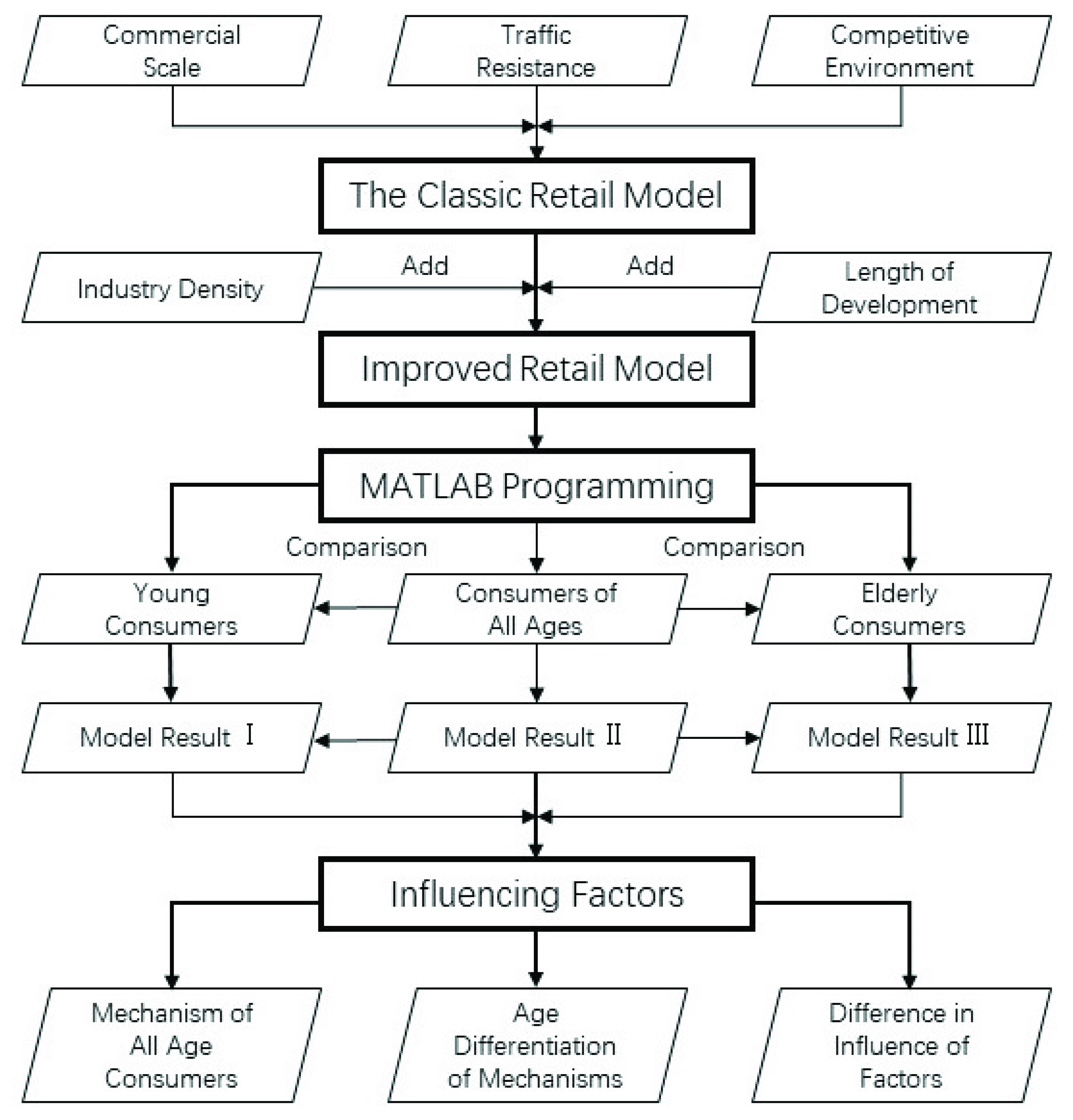

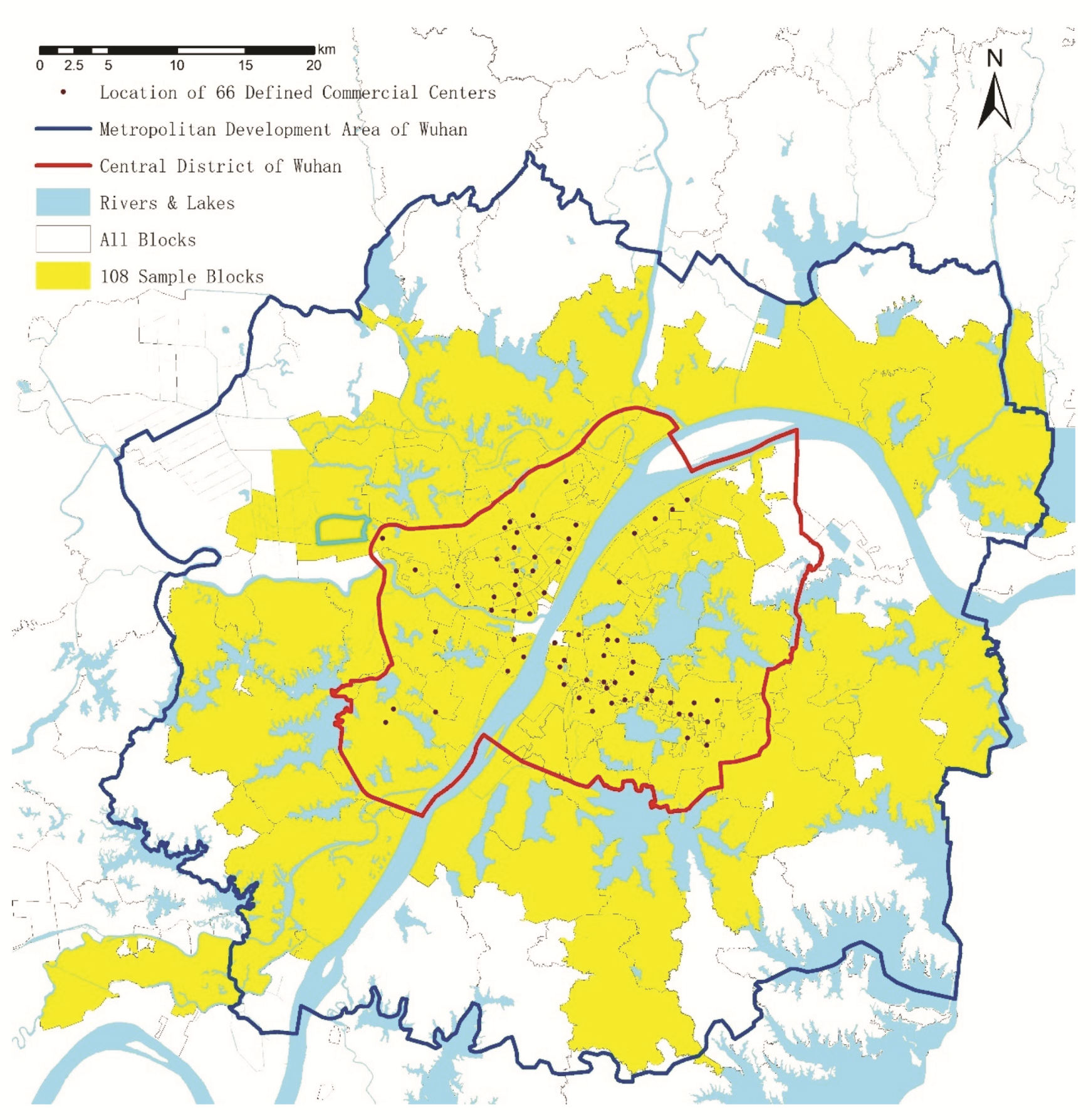

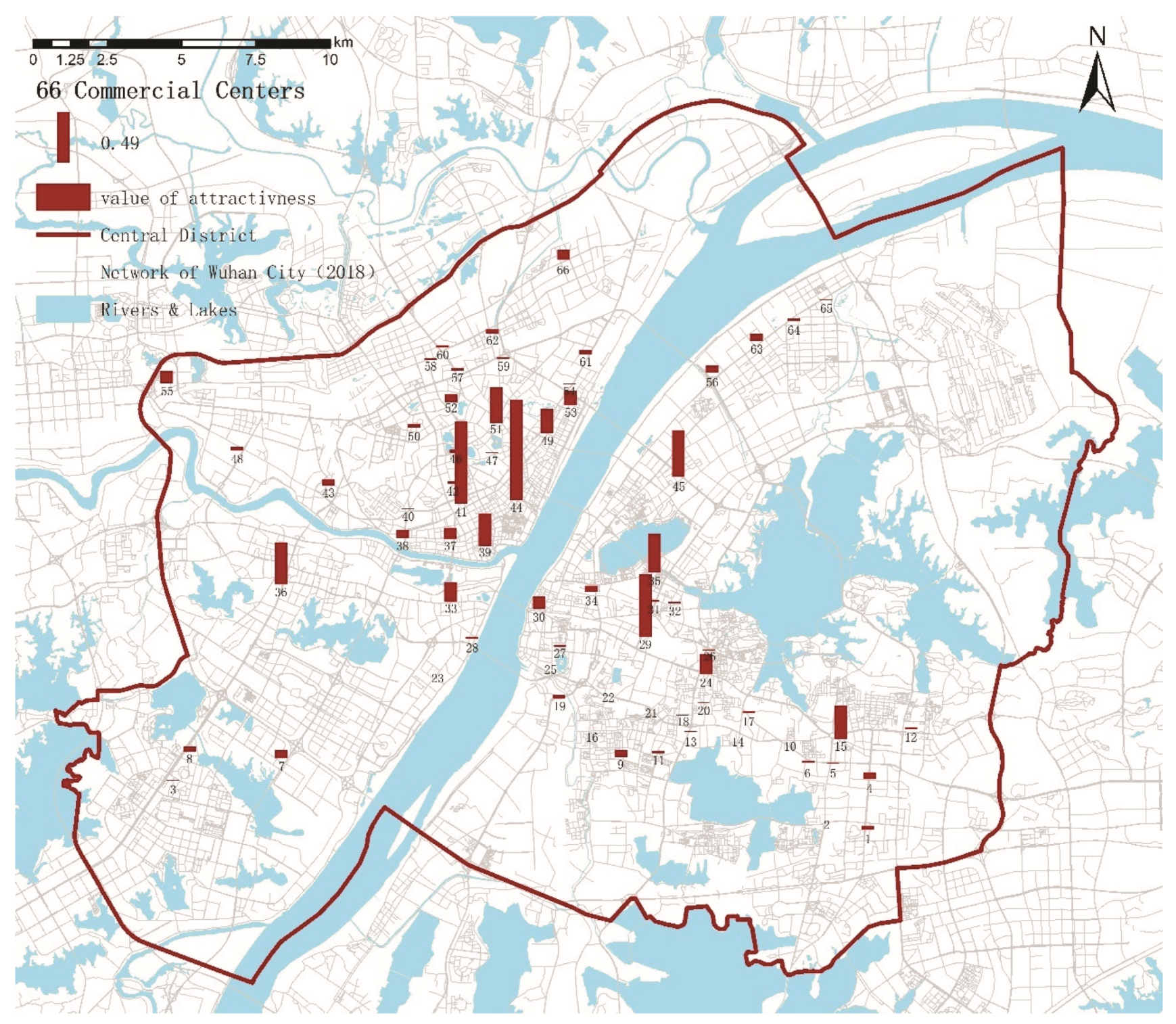
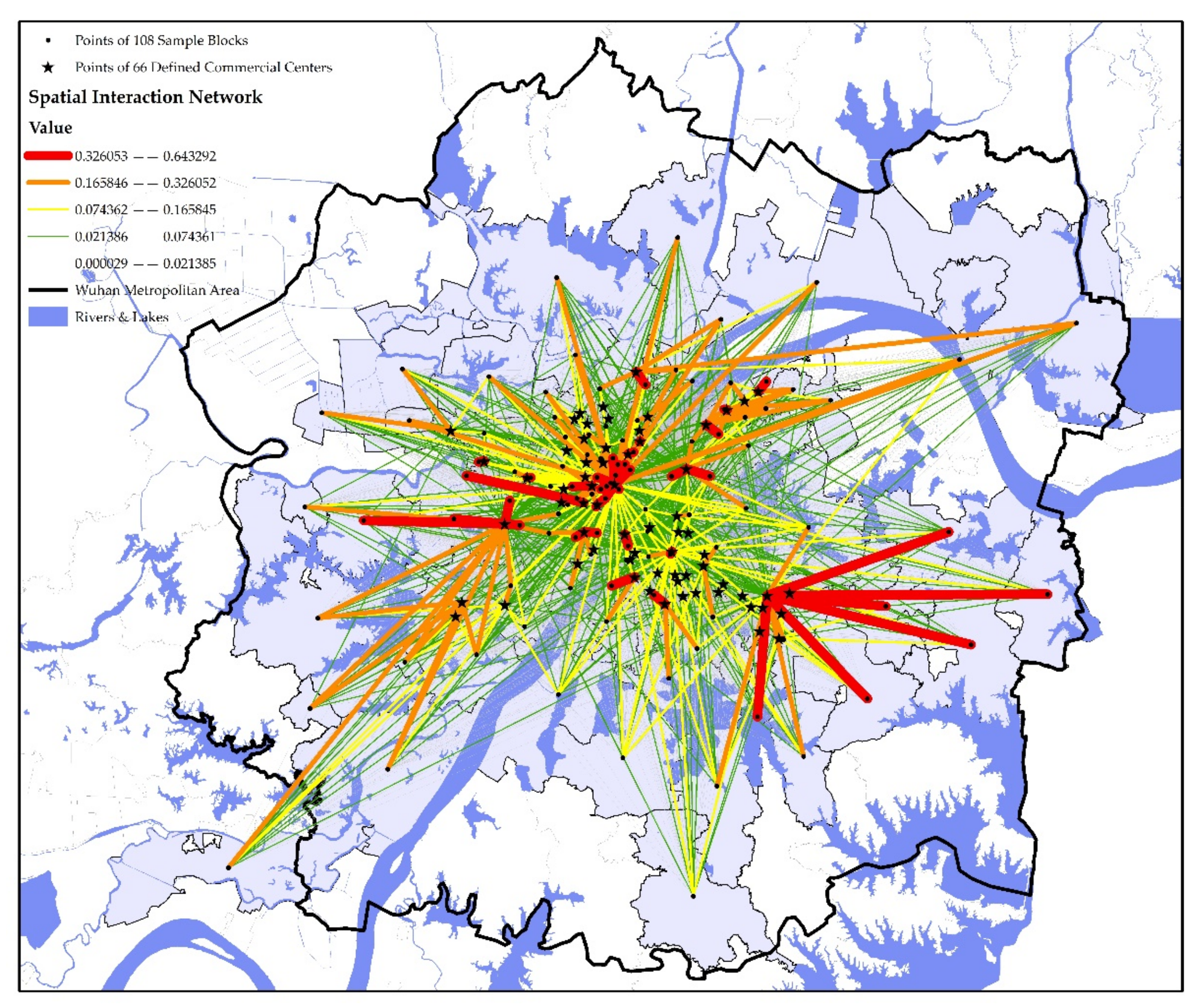
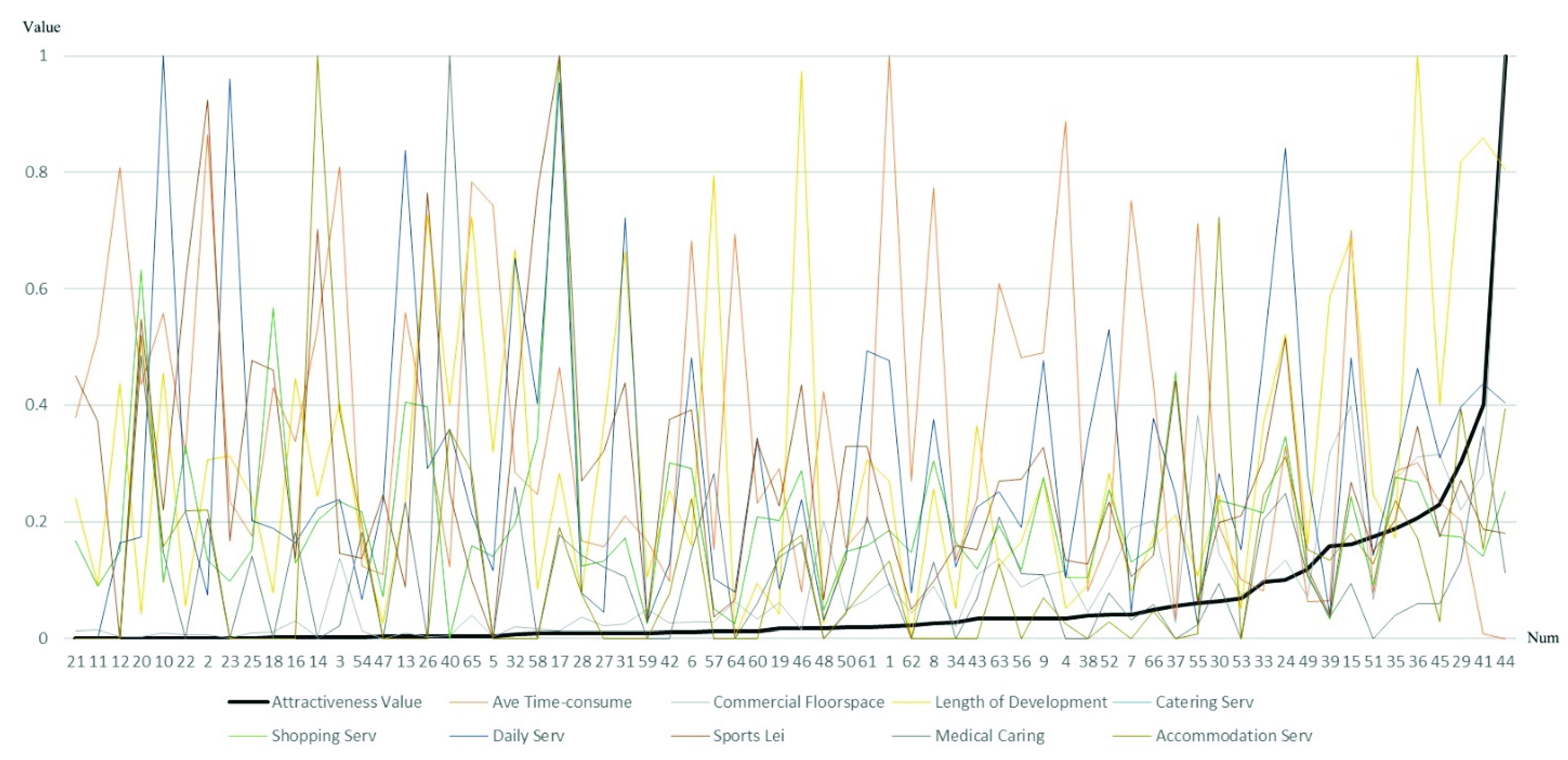
| Num | Level | Name | Conditions | Industry Density | |||||||
|---|---|---|---|---|---|---|---|---|---|---|---|
| Commercial Floorspace | Length of Development | Total | Catering Services | Shopping Services | Daily Services | Sports Leisure | Medical Caring | Accommodation Service | |||
| Density | |||||||||||
| 1 | County-level | Optics Valley World | 92,604.382 | 101 | 13.390 | 5.939 | 0.324 | 4.643 | 1.728 | 0.324 | 0.432 |
| 2 | Community-level | Shuguang Commercial Center (Minzu Avenue) | 10,107.236 | 112 | 18.598 | 4.292 | 3.577 | 0.715 | 8.584 | 0.715 | 0.715 |
| 3 | Xianglong Times Square | 133,832.965 | 141 | 12.850 | 7.546 | 0.299 | 2.316 | 1.345 | 0.075 | 1.270 | |
| 4 | County-level | K11 Select | 113,310.850 | 36 | 5.918 | 3.348 | 0.234 | 1.012 | 1.246 | -- | 0.078 |
| 5 | Community-level | Hung Fu Tim Mei Plaza | 5907.242 | 116 | 9.028 | 4.514 | 3.386 | 1.129 | -- | -- | -- |
| 6 | Parkway Well Fashion Shopping (Xiongchu Avenue) | 30,427.802 | 68 | 19.796 | 9.377 | 0.781 | 4.689 | 3.647 | 0.521 | 0.781 | |
| 7 | County-level | Aeon Mall | 182,814.963 | 45 | 6.181 | 4.212 | 0.438 | 0.438 | 0.985 | 0.109 | -- |
| 8 | Taizihu Commercial Center | 87,684.617 | 97 | 15.130 | 9.808 | 0.304 | 3.649 | 0.912 | 0.456 | -- | |
| 9 | Nanhu Commercial Center | 104,976.591 | 102 | 18.045 | 8.908 | 0.685 | 4.644 | 3.046 | 0.381 | 0.228 | |
| 10 | Community-level | Pop Window Shopping Plaza (Zhuobao Store) | 13,011.725 | 156 | 17.420 | 3.074 | 1.537 | 9.735 | 2.049 | 0.512 | 0.512 |
| 11 | Happy Meeting Plaza, 18 Shucheng Road | 17,328.332 | 48 | 6.925 | 2.885 | 0.577 | -- | 3.463 | -- | -- | |
| 12 | Zhongbai Store (Optics Valley Shopping Plaza) | 6264.802 | 151 | 7.981 | 4.789 | 1.596 | 1.596 | -- | -- | -- | |
| 13 | Vientiane Plaza (luoshi road auxiliary road) | 12,206.950 | 91 | 23.650 | 13.048 | 0.816 | 8.155 | 0.816 | 0.816 | -- | |
| 14 | Zhuodaoquan Plaza | 7009.265 | 93 | 19.573 | 6.524 | 1.087 | 2.175 | 6.524 | -- | 3.262 | |
| 15 | City-level | Optics Valley | 382,600.631 | 225 | 16.371 | 7.846 | 0.398 | 4.684 | 2.483 | 0.328 | 0.586 |
| 16 | Community-level | Nanhu Metropolis | 31,325.756 | 153 | 8.300 | 4.150 | 0.638 | 1.596 | 1.277 | 0.638 | -- |
| 17 | Huquan Shopping Plaza | 16,144.415 | 105 | 54.508 | 32.209 | 2.478 | 9.291 | 9.291 | 0.619 | 0.619 | |
| 18 | Leduhui (Shipailing Road) | 13,789.500 | 44 | 25.617 | 18.298 | 1.220 | 1.830 | 4.270 | -- | -- | |
| 19 | Bandung Plaza (Baishazhou Avenue) | 61,558.748 | 33 | 11.046 | 6.498 | 0.650 | 0.812 | 2.112 | 0.487 | 0.487 | |
| 20 | Longling·818 Square | 5891.584 | 33 | 35.644 | 20.368 | 5.092 | 1.697 | 5.092 | 1.697 | 1.697 | |
| 21 | Ruijing Plaza | 16,713.187 | 92 | 10.770 | 5.385 | 1.197 | -- | 4.188 | -- | -- | |
| 22 | Baihui Life Plaza | 9380.303 | 37 | 21.321 | 10.661 | 2.132 | 2.132 | 5.686 | -- | 0.711 | |
| 23 | Golden Bridge·Moore Street | 4276.234 | 114 | 17.149 | 3.118 | 3.118 | 9.354 | 1.559 | -- | -- | |
| 24 | County-level | Jiedaokou | 130,896.081 | 176 | 27.101 | 11.159 | 0.942 | 8.188 | 4.783 | 0.870 | 1.014 |
| 25 | Community-level | Haida Plaza | 13,562.843 | 93 | 12.780 | 4.915 | 0.983 | 1.966 | 4.424 | 0.492 | -- |
| 26 | Zhongshang Shopping Plaza | 7035.279 | 237 | 25.585 | 12.793 | 2.843 | 2.843 | 7.107 | -- | -- | |
| 27 | Fanyuehui (Shouyi Store) | 23,403.814 | 129 | 8.081 | 4.253 | -- | 0.425 | 2.977 | 0.425 | -- | |
| 28 | Shimao 52 | 38,349.158 | 44 | 8.744 | 3.997 | 0.749 | 0.749 | 2.498 | 0.500 | 0.250 | |
| 29 | City-level | Hongshan Square, Zhongnan Road | 213,151.912 | 264 | 14.383 | 5.606 | 0.643 | 3.860 | 2.527 | 0.460 | 1.287 |
| 30 | County-level | Jiefang Road Simenkou | 142,276.744 | 94 | 15.225 | 7.612 | 0.328 | 2.756 | 1.837 | 0.328 | 2.362 |
| 31 | Community-level | Chutian Fashion Plaza | 27,000.642 | 218 | 17.766 | 5.552 | 0.740 | 7.032 | 4.071 | 0.370 | -- |
| 32 | County-level | Shuiguo Lake Walking Street | 21,871.884 | 219 | 17.669 | 6.343 | 0.453 | 6.343 | 3.624 | 0.906 | -- |
| 33 | Zhongjiacun | 96,259.746 | 130 | 16.885 | 6.932 | 0.889 | 4.710 | 2.844 | 0.711 | 0.800 | |
| 34 | Community-level | Fan Yue Hui | 22,988.723 | 36 | 8.593 | 5.334 | 0.593 | 1.185 | 1.482 | -- | -- |
| 35 | County-level | Chu River Han Street | 263,236.692 | 72 | 15.222 | 8.923 | 0.455 | 2.904 | 1.890 | 0.140 | 0.770 |
| 36 | City-level | Wangjiawan | 298,327.713 | 318 | 17.759 | 8.627 | 0.474 | 4.506 | 3.380 | 0.208 | 0.563 |
| 37 | Community-level | CapitaLand Plaza (Wusheng Store) | 29,206.674 | 84 | 22.255 | 14.723 | 1.027 | 2.397 | 4.109 | -- | -- |
| 38 | Starway Victoria Harbour Shopping Centre | 46,323.166 | 48 | 8.255 | 3.341 | 0.393 | 3.341 | 1.179 | -- | -- | |
| 39 | County-level | Longwang Temple (Hanzheng Street) | 307,449.637 | 195 | 2.980 | 1.055 | 0.590 | 0.404 | 0.372 | 0.124 | 0.435 |
| 40 | Community-level | Times Tianjiao Commercial Center | 8582.637 | 140 | 11.651 | -- | 1.165 | 3.495 | 2.330 | 3.495 | 1.165 |
| 41 | City-level | Wushang Plaza | 270,669.657 | 276 | 12.958 | 4.532 | 0.673 | 4.248 | 1.735 | 1.275 | 0.496 |
| 42 | Community-level | West Park | 28,090.610 | 96 | 15.194 | 9.714 | 0.498 | 1.245 | 3.487 | -- | 0.249 |
| 43 | County-level | Hanxi Commercial Center | 104,817.522 | 129 | 8.447 | 3.833 | 0.782 | 2.190 | 1.408 | 0.235 | -- |
| 44 | City-level | Jianghan Road | 952,847.231 | 260 | 15.859 | 8.097 | 0.451 | 3.938 | 1.671 | 0.394 | 1.287 |
| 45 | Xu Dong | 3,032,85.216 | 140 | 11.115 | 5.721 | 0.477 | 3.010 | 1.609 | 0.209 | 0.089 | |
| 46 | County-level | New World Department Store (Guomao Store) | 17,069.939 | 310 | 18.499 | 9.249 | 1.734 | 2.312 | 4.047 | 0.578 | 0.578 |
| 47 | Community-level | Taipei Yard | 3692.826 | 29 | 6.870 | 2.290 | -- | 2.290 | 2.290 | -- | -- |
| 48 | CapitaLand Plaza, West City | 195,174.110 | 29 | 2.613 | 1.537 | 0.154 | 0.307 | 0.615 | -- | -- | |
| 49 | Sanyang Road | 71,527.250 | 69 | 8.516 | 3.579 | 0.247 | 2.715 | 1.111 | 0.370 | 0.494 | |
| 50 | Oceanwide City Plaza | 49,019.237 | 64 | 10.208 | 4.812 | 0.583 | 1.312 | 3.062 | 0.146 | 0.146 | |
| 51 | County-level | China·China Town | 66,416.992 | 94 | 6.364 | 2.905 | 0.277 | 1.383 | 1.383 | -- | 0.415 |
| 52 | Community-level | Water Chestnut | 106,056.341 | 105 | 16.282 | 8.231 | 0.271 | 5.156 | 2.171 | 0.271 | 0.090 |
| 53 | County-level | Tiandi Yifang Shopping Center | 74,399.759 | 36 | 10.872 | 7.324 | 0.114 | 1.488 | 1.945 | -- | -- |
| 54 | Community-level | Shangdonghui Commercial Plaza | 15,738.484 | 69 | 10.802 | 6.989 | 0.635 | 0.635 | 1.271 | 0.635 | 0.635 |
| 55 | County-level | Zhuyehai | 365,917.726 | 53 | 3.225 | 2.077 | 0.219 | 0.246 | 0.574 | 0.082 | 0.027 |
| 56 | Orsun Century Plaza | 86,725.649 | 70 | 8.840 | 3.767 | 0.307 | 1.845 | 2.537 | 0.384 | -- | |
| 57 | Community-level | Tangjiadun Shopping Plaza | 30,304.499 | 257 | 4.620 | 1.650 | 0.660 | 0.990 | 0.330 | 0.990 | -- |
| 58 | Nuvoton Vanke Plaza | 18,749.358 | 46 | 22.756 | 11.023 | 0.711 | 3.911 | 7.111 | -- | -- | |
| 59 | Hankou Forwardcity | 50,766.242 | 52 | 1.618 | 0.809 | 0.270 | 0.270 | 0.270 | -- | -- | |
| 60 | Happy Chaobei Wanjia Metropolis | 35,641.208 | 49 | 14.479 | 6.715 | 1.049 | 3.358 | 3.148 | 0.210 | -- | |
| 61 | County-level | Erqi Commercial Center | 66,555.014 | 112 | 14.713 | 5.099 | 0.728 | 4.807 | 3.059 | 0.728 | 0.291 |
| 62 | Aeon Mall Wuhan Golden Bridge | 43,727.787 | 21 | 6.251 | 4.726 | 0.305 | 0.762 | 0.457 | -- | -- | |
| 63 | Jianer Road | 133,677.374 | 58 | 12.670 | 6.257 | 0.313 | 2.451 | 2.503 | 0.730 | 0.417 | |
| 64 | Community-level | Impression City Shopping Center | 63,848.891 | 22 | 2.618 | 0.770 | 0.462 | 0.770 | 0.616 | -- | -- |
| 65 | Castle Peak Department Store | 41,010.297 | 236 | 10.653 | 5.095 | 0.695 | 2.084 | 0.926 | 0.926 | 0.926 | |
| 66 | County-level | Houhu | 194,629.826 | 72 | 10.640 | 5.040 | 0.255 | 3.665 | 1.324 | 0.204 | 0.153 |
| Blocks | Jiedaokou | Chu River Han Street | Optics Valley | Jianghan Road | Zhongnan Road | Wangjiawan | … | Total |
|---|---|---|---|---|---|---|---|---|
| Baishazhou Street | 0.026408 | 0.045933 | 0.020228 | 0.054643 | 0.115185 | 0.022616 | 1 | |
| Guanshan Street | 0.038282 | 0.025985 | 0.365569 | 0.053384 | 0.072867 | 0.011635 | 1 | |
| Hanjiadun Street | 0.007521 | 0.013986 | 0.01491 | 0.126534 | 0.028632 | 0.084972 | 1 | |
| Yongfeng Street | 0.009091 | 0.019057 | 0.01614 | 0.062275 | 0.031502 | 0.526787 | 1 | |
| Zhongnan Road | 0.04796 | 0.082271 | 0.031373 | 0.060661 | 0.419601 | 0.015165 | 1 | |
| Jianghan Second Bridge | 0.008875 | 0.015042 | 0.014440433 | 0.066637 | 0.030235 | 0.552497 | 1 | |
| Shuiguo River | 0.035638 | 0.260984 | 0.020907044 | 0.053908 | 0.135928 | 0.012351 | 1 | |
| … | 1 |
| Planning Level | Attractiveness Value | Commercial Floorspace | Length of Development | Total Industry Density | ||||||||||||
|---|---|---|---|---|---|---|---|---|---|---|---|---|---|---|---|---|
| Average | Max | Min | Std.D | Ave | Max | Min | Std.D | Ave | Max | Min | Std.D | Ave | Max | Min | Std.D | |
| City-level | 0.597 | 0.982 | 0.321 | 0.231 | 403,480 | 952,847 | 213,151 | 250,732 | 247 | 318 | 140 | 55 | 14 | 17 | 11 | 2.216 |
| County-level | 0.120 | 0.376 | 0.016 | 0.104 | 128,443 | 365,917 | 17,069 | 88,037 | 105 | 310 | 21 | 68 | 12 | 27 | 2 | 5.866 |
| Community-level | 0.025 | 0.237 | 0.000 | 0.042 | 33,878 | 195,174 | 3692 | 37,869 | 95 | 257 | 22 | 61 | 14 | 54 | 1 | 9.734 |
| Explanatory Variables | Influence Level | Model Estimation | Observed Value vs. Calculated Value | ||||
|---|---|---|---|---|---|---|---|
| Correlation Coefficient | T-Stat | R2 | Reliability | Correlation Coefficient | SE | T-Stat | |
| TAD_Time | −0.03124723 | −841.836439 | 0.638 | 0.0278 | 0.9646 | 0.008601 | 112.16 |
| CC_Age | 0.000276344 | 16.6397536 | |||||
| Shop_POI_Den | 0.124398252 | 32.79476398 | |||||
| DaiSer_POI_Den | 0.013707401 | 14.83760288 | |||||
| Med_POI_Den | 0.109029475 | 25.50235825 | |||||
| Acc_POI_Den | −0.035435085 | −49.5415711 | |||||
| SpoLei_POI_Den | 0.098482894 | 71.69963251 | |||||
| Explanatory Variables | R2 | Observed Value vs. Calculated Value | Correlation Coefficient | T-Stat | SE |
|---|---|---|---|---|---|
| TAD_Time | 0.787 | y = 0.9477x + 0.00079 | −0.024763 | −536.65 | 0.0000461 |
| CC_Age | 0.00051346 | 20.012 | 0.0000257 | ||
| Shop_POI_Den | 0.27548 | 63.367 | 0.0043474 | ||
| Med_POI_Den | 0.052481 | 10.037 | 0.0052288 | ||
| DaiSer_POI_Den | 0.043514 | 34.027 | 0.0012788 | ||
| SpoLei_POI_Den | 0.03125 | 17.211 | 0.0018157 | ||
| Acc_POI_Den | −0.0096947 | −2.6069 | 0.0037189 |
| Explanatory Variables | R2 | Observed Value vs. Calculated Value | Correlation Coefficient | T-Stat | SE |
|---|---|---|---|---|---|
| TAD_Time | 0.662 | y = 0.91798x + 0.00124 | −0.039966 | −695.98 | 0.0000574 |
| CC_Age | −0.00013044 | −6.1671 | 0.0000212 | ||
| Shop_POI_Den | 0.045025 | 6.7363 | 0.0066839 | ||
| Med_POI_Den | 0.062739 | 12.252 | 0.0051206 | ||
| DaiSer_POI_Den | 0.018094 | 14.145 | 0.0012793 | ||
| SpoLei_POI_Den | 0.14104 | 74.294 | 0.0018983 | ||
| Acc_POI_Den | −0.19844 | −51.512 | 0.0038523 |
| Name | Main Source of Customers and Their Average Age (Years) | Construction Weakness | |||||
|---|---|---|---|---|---|---|---|
| Commercial Scale | Traffic Accessibility | Domestic Services | Sports Leisure | Medical Care | Shopping Service | ||
| Hanxi Commercial Center | Zongguan Street (45) | ● | ●●● | ●● | ●●● | ||
| Hanjiadun Street (43) | |||||||
| Water chestnut commercial center | Tangjiadun Street (44) | ●● | ●●● | ||||
| Changqing (40) | |||||||
| North Lake Street (46) | |||||||
| Jianer Road Commercial Center | Hongwei Road (45) | ●●● | ●● | ● | |||
| Ganghua Street (46) | |||||||
| Wuhan Iron and Steel Plant (47) | |||||||
| Nanhu Commercial Center | Nanhu Street (39) | ●● | |||||
| Hongshan Street (32) | |||||||
| Lion Rock Street (32) | |||||||
| Taizihu Road Commercial Center | Zhuankou Street (37) | ●● | ●●● | ●●● | ● | ||
| Daji Street (42) | |||||||
| Junshan Street (36) | |||||||
| Caidian Changfu Street (44) | |||||||
| Erqi Commercial Center | Erqi Street (43) | ●●● | ●● | ||||
Publisher’s Note: MDPI stays neutral with regard to jurisdictional claims in published maps and institutional affiliations. |
© 2021 by the authors. Licensee MDPI, Basel, Switzerland. This article is an open access article distributed under the terms and conditions of the Creative Commons Attribution (CC BY) license (https://creativecommons.org/licenses/by/4.0/).
Share and Cite
Shan, Z.; Wu, Z.; Yuan, M. Exploring the Influence Mechanism of Attractiveness on Wuhan’s Urban Commercial Centers by Modifying the Classic Retail Model. ISPRS Int. J. Geo-Inf. 2021, 10, 652. https://doi.org/10.3390/ijgi10100652
Shan Z, Wu Z, Yuan M. Exploring the Influence Mechanism of Attractiveness on Wuhan’s Urban Commercial Centers by Modifying the Classic Retail Model. ISPRS International Journal of Geo-Information. 2021; 10(10):652. https://doi.org/10.3390/ijgi10100652
Chicago/Turabian StyleShan, Zhuoran, Zhe Wu, and Man Yuan. 2021. "Exploring the Influence Mechanism of Attractiveness on Wuhan’s Urban Commercial Centers by Modifying the Classic Retail Model" ISPRS International Journal of Geo-Information 10, no. 10: 652. https://doi.org/10.3390/ijgi10100652
APA StyleShan, Z., Wu, Z., & Yuan, M. (2021). Exploring the Influence Mechanism of Attractiveness on Wuhan’s Urban Commercial Centers by Modifying the Classic Retail Model. ISPRS International Journal of Geo-Information, 10(10), 652. https://doi.org/10.3390/ijgi10100652





